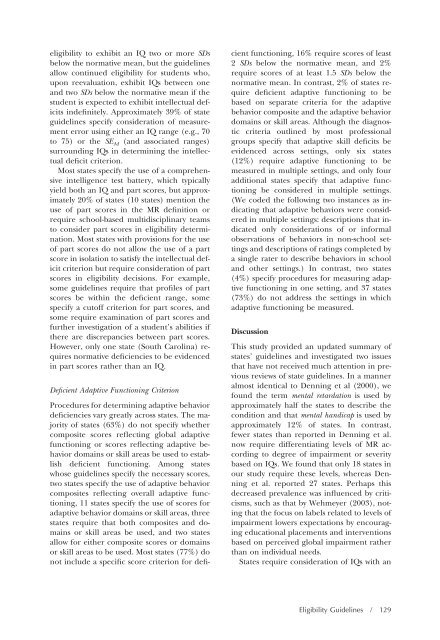Download the Journal (PDF) - Division on Autism and ...
Download the Journal (PDF) - Division on Autism and ...
Download the Journal (PDF) - Division on Autism and ...
You also want an ePaper? Increase the reach of your titles
YUMPU automatically turns print PDFs into web optimized ePapers that Google loves.
eligibility to exhibit an IQ two or more SDs<br />
below <str<strong>on</strong>g>the</str<strong>on</strong>g> normative mean, but <str<strong>on</strong>g>the</str<strong>on</strong>g> guidelines<br />
allow c<strong>on</strong>tinued eligibility for students who,<br />
up<strong>on</strong> reevaluati<strong>on</strong>, exhibit IQs between <strong>on</strong>e<br />
<strong>and</strong> two SDs below <str<strong>on</strong>g>the</str<strong>on</strong>g> normative mean if <str<strong>on</strong>g>the</str<strong>on</strong>g><br />
student is expected to exhibit intellectual deficits<br />
indefinitely. Approximately 39% of state<br />
guidelines specify c<strong>on</strong>siderati<strong>on</strong> of measurement<br />
error using ei<str<strong>on</strong>g>the</str<strong>on</strong>g>r an IQ range (e.g., 70<br />
to 75) or <str<strong>on</strong>g>the</str<strong>on</strong>g> SE M (<strong>and</strong> associated ranges)<br />
surrounding IQs in determining <str<strong>on</strong>g>the</str<strong>on</strong>g> intellectual<br />
deficit criteri<strong>on</strong>.<br />
Most states specify <str<strong>on</strong>g>the</str<strong>on</strong>g> use of a comprehensive<br />
intelligence test battery, which typically<br />
yield both an IQ <strong>and</strong> part scores, but approximately<br />
20% of states (10 states) menti<strong>on</strong> <str<strong>on</strong>g>the</str<strong>on</strong>g><br />
use of part scores in <str<strong>on</strong>g>the</str<strong>on</strong>g> MR definiti<strong>on</strong> or<br />
require school-based multidisciplinary teams<br />
to c<strong>on</strong>sider part scores in eligibility determinati<strong>on</strong>.<br />
Most states with provisi<strong>on</strong>s for <str<strong>on</strong>g>the</str<strong>on</strong>g> use<br />
of part scores do not allow <str<strong>on</strong>g>the</str<strong>on</strong>g> use of a part<br />
score in isolati<strong>on</strong> to satisfy <str<strong>on</strong>g>the</str<strong>on</strong>g> intellectual deficit<br />
criteri<strong>on</strong> but require c<strong>on</strong>siderati<strong>on</strong> of part<br />
scores in eligibility decisi<strong>on</strong>s. For example,<br />
some guidelines require that profiles of part<br />
scores be within <str<strong>on</strong>g>the</str<strong>on</strong>g> deficient range, some<br />
specify a cutoff criteri<strong>on</strong> for part scores, <strong>and</strong><br />
some require examinati<strong>on</strong> of part scores <strong>and</strong><br />
fur<str<strong>on</strong>g>the</str<strong>on</strong>g>r investigati<strong>on</strong> of a student’s abilities if<br />
<str<strong>on</strong>g>the</str<strong>on</strong>g>re are discrepancies between part scores.<br />
However, <strong>on</strong>ly <strong>on</strong>e state (South Carolina) requires<br />
normative deficiencies to be evidenced<br />
in part scores ra<str<strong>on</strong>g>the</str<strong>on</strong>g>r than an IQ.<br />
Deficient Adaptive Functi<strong>on</strong>ing Criteri<strong>on</strong><br />
Procedures for determining adaptive behavior<br />
deficiencies vary greatly across states. The majority<br />
of states (63%) do not specify whe<str<strong>on</strong>g>the</str<strong>on</strong>g>r<br />
composite scores reflecting global adaptive<br />
functi<strong>on</strong>ing or scores reflecting adaptive behavior<br />
domains or skill areas be used to establish<br />
deficient functi<strong>on</strong>ing. Am<strong>on</strong>g states<br />
whose guidelines specify <str<strong>on</strong>g>the</str<strong>on</strong>g> necessary scores,<br />
two states specify <str<strong>on</strong>g>the</str<strong>on</strong>g> use of adaptive behavior<br />
composites reflecting overall adaptive functi<strong>on</strong>ing,<br />
11 states specify <str<strong>on</strong>g>the</str<strong>on</strong>g> use of scores for<br />
adaptive behavior domains or skill areas, three<br />
states require that both composites <strong>and</strong> domains<br />
or skill areas be used, <strong>and</strong> two states<br />
allow for ei<str<strong>on</strong>g>the</str<strong>on</strong>g>r composite scores or domains<br />
or skill areas to be used. Most states (77%) do<br />
not include a specific score criteri<strong>on</strong> for defi-<br />
cient functi<strong>on</strong>ing, 16% require scores of least<br />
2 SDs below <str<strong>on</strong>g>the</str<strong>on</strong>g> normative mean, <strong>and</strong> 2%<br />
require scores of at least 1.5 SDs below <str<strong>on</strong>g>the</str<strong>on</strong>g><br />
normative mean. In c<strong>on</strong>trast, 2% of states require<br />
deficient adaptive functi<strong>on</strong>ing to be<br />
based <strong>on</strong> separate criteria for <str<strong>on</strong>g>the</str<strong>on</strong>g> adaptive<br />
behavior composite <strong>and</strong> <str<strong>on</strong>g>the</str<strong>on</strong>g> adaptive behavior<br />
domains or skill areas. Although <str<strong>on</strong>g>the</str<strong>on</strong>g> diagnostic<br />
criteria outlined by most professi<strong>on</strong>al<br />
groups specify that adaptive skill deficits be<br />
evidenced across settings, <strong>on</strong>ly six states<br />
(12%) require adaptive functi<strong>on</strong>ing to be<br />
measured in multiple settings, <strong>and</strong> <strong>on</strong>ly four<br />
additi<strong>on</strong>al states specify that adaptive functi<strong>on</strong>ing<br />
be c<strong>on</strong>sidered in multiple settings.<br />
(We coded <str<strong>on</strong>g>the</str<strong>on</strong>g> following two instances as indicating<br />
that adaptive behaviors were c<strong>on</strong>sidered<br />
in multiple settings: descripti<strong>on</strong>s that indicated<br />
<strong>on</strong>ly c<strong>on</strong>siderati<strong>on</strong>s of or informal<br />
observati<strong>on</strong>s of behaviors in n<strong>on</strong>-school settings<br />
<strong>and</strong> descripti<strong>on</strong>s of ratings completed by<br />
a single rater to describe behaviors in school<br />
<strong>and</strong> o<str<strong>on</strong>g>the</str<strong>on</strong>g>r settings.) In c<strong>on</strong>trast, two states<br />
(4%) specify procedures for measuring adaptive<br />
functi<strong>on</strong>ing in <strong>on</strong>e setting, <strong>and</strong> 37 states<br />
(73%) do not address <str<strong>on</strong>g>the</str<strong>on</strong>g> settings in which<br />
adaptive functi<strong>on</strong>ing be measured.<br />
Discussi<strong>on</strong><br />
This study provided an updated summary of<br />
states’ guidelines <strong>and</strong> investigated two issues<br />
that have not received much attenti<strong>on</strong> in previous<br />
reviews of state guidelines. In a manner<br />
almost identical to Denning et al (2000), we<br />
found <str<strong>on</strong>g>the</str<strong>on</strong>g> term mental retardati<strong>on</strong> is used by<br />
approximately half <str<strong>on</strong>g>the</str<strong>on</strong>g> states to describe <str<strong>on</strong>g>the</str<strong>on</strong>g><br />
c<strong>on</strong>diti<strong>on</strong> <strong>and</strong> that mental h<strong>and</strong>icap is used by<br />
approximately 12% of states. In c<strong>on</strong>trast,<br />
fewer states than reported in Denning et al.<br />
now require differentiating levels of MR according<br />
to degree of impairment or severity<br />
based <strong>on</strong> IQs. We found that <strong>on</strong>ly 18 states in<br />
our study require <str<strong>on</strong>g>the</str<strong>on</strong>g>se levels, whereas Denning<br />
et al. reported 27 states. Perhaps this<br />
decreased prevalence was influenced by criticisms,<br />
such as that by Wehmeyer (2003), noting<br />
that <str<strong>on</strong>g>the</str<strong>on</strong>g> focus <strong>on</strong> labels related to levels of<br />
impairment lowers expectati<strong>on</strong>s by encouraging<br />
educati<strong>on</strong>al placements <strong>and</strong> interventi<strong>on</strong>s<br />
based <strong>on</strong> perceived global impairment ra<str<strong>on</strong>g>the</str<strong>on</strong>g>r<br />
than <strong>on</strong> individual needs.<br />
States require c<strong>on</strong>siderati<strong>on</strong> of IQs with an<br />
Eligibility Guidelines / 129
















